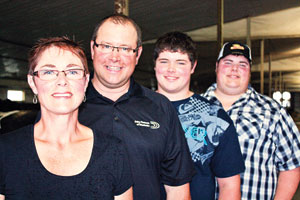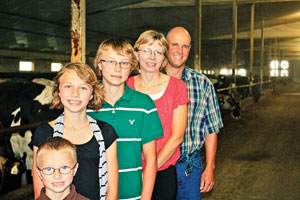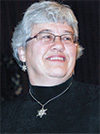Grandfather was a cream producer, shipping cans to Winnipeg by train. He had pride in his purebred Holstein herd and showed his cows, even traveling on occasion to Toronto for the Royal Agricultural Winter Fair. In 1961, Dad took over, and the brothers in 1995.
In 1999, the brothers faced a major decision – would they get bigger in grain farming or use the land for feed production and go big with the dairy? “We decided on the latter because our skills were stronger in that choice,” Henry explains.
As the old barns were not equipped to handle that type of expansion, a new facility was built about a mile south of the original homestead in Rosser, Manitoba.

Today, the dairy employs 13 full-time workers, in addition to Henry and his wife, Laura; Tony and his wife, Kim; and Henry’s older son, Benjamin.
Each of them has their area of expertise to contribute. The brothers and their wives all have part ownership in the enterprise.
Henry takes care of administration and the milking cow facility. Laura handles human resources and farm safety; Kim takes care of the office and accounting.
Tony is responsible for machinery and building maintenance, nursery and youngstock facilities.
Benjamin came on board full-time in the fall of 2010 and is in charge of crop production. Family working together is what suits Henry best. “Wouldn’t farm with anybody else,” he says.
Due to the size of the new facility, it was necessary for the family to acquire skills in working with employees.
Without a constant family presence, they learned to be able to trust their workers. Henry admits to having to learn a lot on the run and needing the ability to adjust.

The system they developed allows many people to be involved and makes use of workers’ skills. It also allows for time off, on average two days per month, some weekends and three weeks of holidays.
The Rosser herd consists of purebred cows, mostly Holstein, with a few Jerseys as well. The brothers make use of DHI (Dairy Herd Improvement) and young sire proving programs, and the cows are classified for type.
Cow comfort is an important part of the management of this herd. The large freestall barn, measuring 320 feet by 160 feet, contains a number of features designed to keep cows comfortable, which also keeps cows producing well. Stalls are a roomy 48 inches wide, with mattresses.
These are covered with an inch of bedding, which is a combination of flax chives and straw, providing a soft and inviting spot to lie up. The comfort factor helps avoid injuries and lameness.
Five hundred cows can produce a lot of heat; the barn is equipped with tunnel ventilation – a bank of fans along one end.
The intake is at the opposite end, producing a 10 kilometre-per-hour breeze inside. Besides this, there are misters for use in hot weather.
These produce a very fine mist which is spread by fans and can drop the temperature in the barn by 6°C. As the mist is very fine, the cows don’t get wet, but feel the cooling benefit, which keeps feed consumption up and ensures production does not drop in hot spells.
Cows are grouped in four pens, according to their lactation stage, with 2-year-olds and higher production cows accommodated separately.
The second barn at the new location is used for bred heifers, dry cows, cows due within 30 days, and cows for 30 days postcalving.
This group has special care; they are milked six times daily, at the beginning and end of each milking cycle. Management like this encourages the cows to increase their dry matter intake, which helps boost their immune system, resulting in healthier cows.
They tend to lose less weight when they hit peak production, and the more frequent milking increases their level of production. This barn also houses special-needs cows – older cows, or those with health or mobility issues.
The staff keeps a close watch on these cows. This barn utilizes bedding packs, which Henry admits take lots of bedding, and does affect milk quality.
Henry states their goal is profitable production, with long-living, “low event” cows, “not high production at any cost ... the measure is not the highest production, but the overall picture.”
Milking takes place in a double-12 parallel parlour with an adjoining holding area. Cows have 28 inches of space, with milkers attached from the rear.
This setup allows one person to milk 100 cows per hour. Cows are milked three times per day, except as mentioned above. Transponders on the cows provide information for identifying cows that are in season or ill, and flags unusual activity. In addition, two herdsmen give visual attention to the cows.
The brothers raise their own heifers, housing them at the barn on the original homestead until approximately 1 year old.
They plan to build a youngstock barn with a new climate-controlled calf nursery, which they say should reduce weather, temperature and moisture variables.
Two thousand acres of land, mostly owned by the family, is used to produce corn, barley and alfalfa. Feed is made on farm, using a TMR mixer.
Purchased protein packs and minerals are added to their homegrown crops. Henry explains they have “changed from the art of feeding to the science of feeding.” He adds, “That’s what computers are for.”
Manure is turned back into the operation. Bedding packs from the old barn are stored and spread annually. The new barn has liquid storage into lagoons, and is also put onto crops on a yearly basis, using a dragline system.
The Holtmann family welcomes visitors to their operation. A home school group, young kids, the Dairy Farmers of Manitoba, public school, and college students have all visited.
In addition to farming, Henry is involved in his local church, is a director with the local credit union and is a director of Dairy Farmers of Manitoba.
He enjoys public speaking and representing dairymen nationally, working on issues that affect dairy farmers.
He loves traveling and has hopes of someday visiting Europe, experiencing different cultures. In the meantime, he is enjoying his own small hamlet, where he says he has great neighbours and a very good community. PD
Alice Guthrie is a freelance writer from Hagersville, Ontario.









